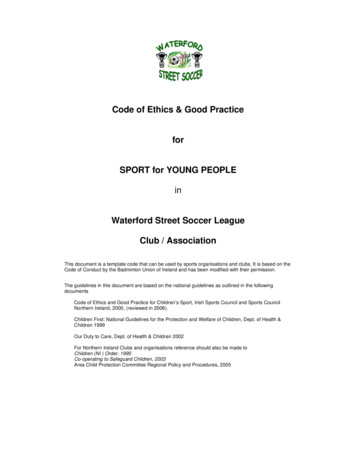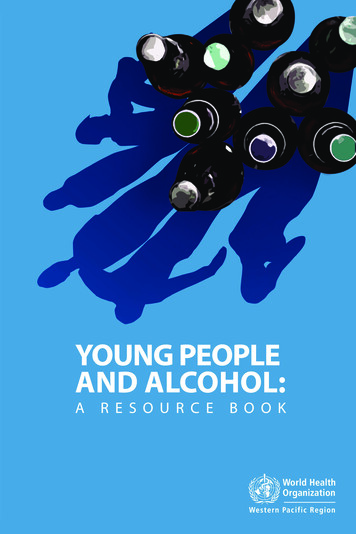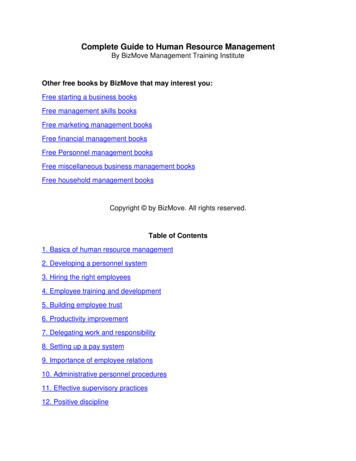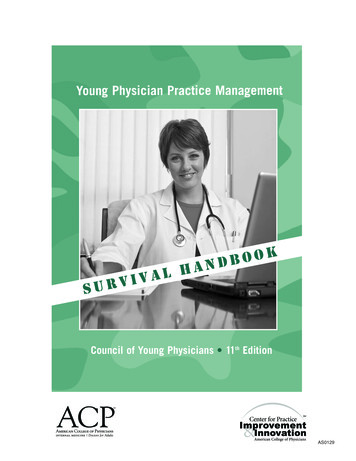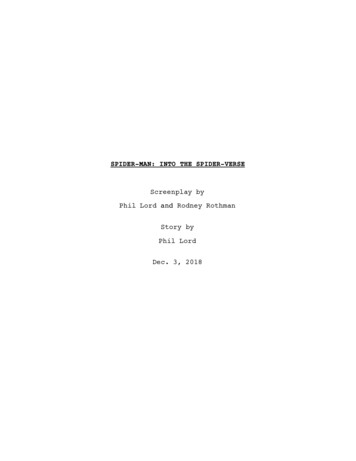
Transcription
Other Health Booksby Roger MasonLower Blood Pressure Without DrugsLower Cholesterol Without DrugsThe Minerals You NeedThe Natural Diabetes CureThe Natural Prostate CureNatural Health for WomenThe Supplements You NeedTestosterone Is Your FriendWhat is Beta Glucan?
A PRACTICAL & DELICIOUS APPROACH TO EATING RIGHTFOR BETTER HEALTH, NATURAL BALANCE, AND LESS STRESS
Macrobiotics for Everyone is not intended as medical advice. It is written solely for informational and educational purposes. Please consult a health professional should theneed for one be indicated. Because there are always some risks involved, the authorand publisher are not responsible for any adverse affects or consequences resultingfrom the use of any of the suggestions, preparations, or methods described in the book.The publisher does not advocate the use of any particular diet or health program, butbelieves the information presented in this book should be available to the public.All listed addresses, phone numbers, and fees have been reviewed and updated during production. However, the data is subject to change.EDITOR:Erica ShurCOVER DESIGNER: Jeannie TudorTYPESETTER: Gary A. RosenbergSquare One Publishers115 Herricks RoadGarden City Park, NY 11040(516) 535-2010 (877) 900-BOOKwww.squareonepublishers.comLibrary of Congress Cataloging-in-Publication DataMason, Roger, 1946Macrobiotics for everyone : a practical & delicious approach to eating rightfor better health, natural balance, and less stress / Roger Mason.pages cm1. Macrobiotic diet. 2. Diet—Religious aspects—Zen Buddhism. 3.Meditation—Zen Buddhism. 4. Pets—Nutrition. I. Title.RM235.M352 2013613.2'64—dc232013017871Copyright 2013 by Roger MasonAll rights reserved. No part of this transmission may be reproduced,stored in a retrieval system, or transmitted, in any form or by anymeans, electronic, mechanical, photocopying, recording, or otherwise, without the prior written permission of the copyright owner.10987654321
ContentsIntroduction, 11. What is Macrobiotics?, 32. Yin and Yang, 83. Whole Grains, 114. Beans Are Good Food, 185. Vegetables, 216. Tropical and Nightshade Foods, 267. Fruits and Sugars, 318. Seafood, Meat, Poultry and Dairy, 369. Fats and Oils, 4310. Condiments and Seasonings, 4711. Everyday Eating, 5012. Calorie Restriction and Fasting, 5513. Other Diets, 6114. Natural Hormone Balance, 6615. Testing Your Hormones, 7316. Natural Supplements, 7817. Meditation, 8918. Exercise, 9119. Curing the Incurable, 9620. Caring For Your Pets, 101
Seven Steps to Natural Health, 105Recommended Reading, 107About the Author, 111Index, 113
IntroductionGeorge Ohsawa, a philosopher and writer, came to the United States inthe early sixties and brought us the macrobiotic diet and lifestyle. Macrobiotics is a philosophy and a holistic approach that stresses the importance of proper dietary and lifestyle habits. For many years, it was clearthat all the books on this subject were heavily influenced by Japanese culture, written by Japanese people (or with their outlook) and featuringJapanese cooking and Japanese ingredients. It became apparent there wasa need for a book making macrobiotics more practical, more universal, moredown to earth, more fun, tastier, more creative, sexier, less restrictive, moreappealing, and without all the Japanese clothing. This book provides uswith all this, without watering macrobiotics down or weakening it. Therewere just too many unneeded limitations, and too much cultural influencethat simply did not translate. Why use expensive, hard-to-find Japanesevegetables, few soups, tea with caffeine (bancha), buckwheat noodles withwhite flour, refined couscous, no salads, very limited seasonings and condiments, few fresh green and yellow vegetables, all that salt, no supplements,no natural hormones, almost no raw foods, and no fasting? This book is forall cultures around the world.There are so many natural health books today about the right foods toeat, and so many contradictory philosophies. How can one know what isvalid and what is not? So many authors are very convincing. The answer isvery simple—results. The macrobiotic way of eating is the only proven wayof curing “incurable” illnesses such as the various cancers, diabetes, heartand artery problems, arthritis, osteoporosis, and the wide variety of illnesses that plague modern society, especially in the developed nations.You have to experience this for yourself. Nature is the greatest healer,1
2Macrobiotics for Everyoneand our diet and lifestyle will allow Nature to heal us. If we are in harmony with the Natural Order, we will be healthy and happy. If we are ignorant of the Natural Order, we will be sickly and unhappy. Buddha saidignorance (to ignore), not sin, is the root cause of suffering. This is simple,clear, practical, and realistic.We are literally what we eat. Diet causes illness, and diet cures illness. Wemust take responsibility for our health, and our very destiny. We must treat thecause of our illness, whether this is mental, emotional, physical, or spiritual, and not just try to remove the symptom. You cannot cure yourself bybeing butchered, poisoned, and irradiated. Make better food choices, takeproven supplements, balance your hormones, fast weekly, end any badhabits, and exercise. This is what natural health is all about.
1. What Is Macrobiotics?The macrobiotic way of living is based on being in harmony with the Universal Order by eating well and living well. The word “macrobiotic”comes from the Greek words “macro,” or great, and “bios,” or life. Hippocrates (the Father of Medicine) and Herodotus used this way of eatingnatural foods to regain health and to treat their patients. This way of eatingwas popularized in Europe and America in the 1960s, especially amongyounger people. George Ohsawa was the main source of information, withhis rather basic books Zen Macrobiotics and You Are All Sanpaku. WilliamDufty and his book Sugar Blues were also popular. Then along came MichioKushi, Herman Aihara, and other writers. These few authors had animmense influence, which is still strong today simply because this methodof healing works. Their claims that you could cure cancer and other terminal illnesses with diet and lifestyle proved to be true. Real world experienceover the decades have shown it to work. One can certainly wonder how apoor immigrant like George Ohsawa showed up here in America with nomoney, no credentials, or anything but his dream, yet could have such atremendous influence on American society. Four decades later, and longafter his death, macrobiotics is stronger than ever. There is an old saying:“One man plus truth equals an army.” This is how George did it; he wasmerely a messenger with a vital, life-changing message that people herewere ready to receive. His little paperback books became more and morepopular. People found they made sense, and the advice really worked.Those who changed their way of eating, and their way of life, got the resultshe promised. They cured their illnesses by changing their direction and verydestiny.3
4Macrobiotics for EveryoneMACROBIOTIC THEORYThe underlying theory of macrobiotics is really very simple. The essence ofall this is simplicity. Thoreau said, “Simplify, simplify, simplify.” Macrobiotic principles can be adapted to all the areas of our life, and they advocatethat one should rely on the body’s natural ability to heal itself of illness.Allow the powers of the universe to heal you.DietIn current Western religions, dietetic principles are almost ignored completely. Some Seventh Day Adventists, Buddhist, and Hindu sects stillobserve some of them. Even the Catholics have given up abstaining frommeat on Fridays. Kosher and halal foods are not based on health principles.In original Christianity, such principles were integral. In Japan today, thistype of eating is called shojin ryori, and is still popular in the countryside(but generally not the city). Our biology and physiology are ignored insteadof cared for. The teachings of the ancient religions always taught the body isa holy temple of the spirit. These teachings exhibit the importance of healthful eating and drinking, as well as avoiding harmful practices like coffee,tobacco, alcohol, desserts, and prescription drugs. The Code of Manu, theBible, Canon of the Yellow Emperor, I Ching, Tao Te Ching, Bhagavad Gita,and Charak Samhita all speak of taking care of our earthly abode of consciousness, our physical body. You must be your own doctor, you must takeresponsibility for your health and happiness, and you must heal yourselfwhen ill. Only you can heal yourself. “Physician, heal thyself.” Be your owndoctor! Be responsible for your life. Japanese macrobiotics overstressed wholegrains. The traditional classification was seven levels of eating. One hundred percent whole grains were at the top. The lowest level was 40 percentgrains. The idea of eating only whole grains as the ultimate diet is obviouslyunrealistic, and unhealthful for several reasons. No one can eat diet #7 (adiet that advocates eating only brown rice with a little sesame salt for aperiod of days, weeks, and sometimes months) with 100 percent wholegrains for any length of time. You could only eat such a diet very temporarily, to heal and cleanse yourself. Such a regimen is seriously lacking invitamins (especially vitamins A and D), minerals, and plant nutrients suchas sterols and lignans. Only 50 to 60 percent of our diet should be wholegrains as our principal food. Dried beans are included with grains for simplicity, and because they are so close as principal foods. Soup should consist of whole grains and beans, along with vegetables in any combination.In Japanese macrobiotics, only 5 percent was allowed to be soup, but no
What Is Macrobiotics?5realistic explanation for such a limitation was given. A daily bowl of hot flavorful soup before dinner (and lunch as well) allows you to eat less foodand feel full on fewer calories. Soups are no different from regular food, aslong as you carefully chew the solids in your soup, and do not swallowunchewed food. Therefore, a very ideal and practical diet for most peoplewould be about 50 percent whole grains and beans, 30 percent vegetables,10 percent seafood, and 10 percent salads and/or fruits. A practical diet forthe vegetarian would be about 50 percent grains and beans, 30 percent vegetables, 10 percent salads, and 10 percent fruits. These two diets would basically suit everyone, and would, in fact, cure so-called “incurable” illnessessuch as cancer. Seafood should be limited to 10 percent. You can eat 10 percent fresh salad regularly as long as you use a light and healthy dressing.You can eat up to 10 percent local fruit, especially in the summer, but youreally don’t need fruit at all, especially in winter. You’ll see why this is truein Chapter 7. Macrobiotic desserts are a temporary transition and an occasional treat, not a regular part of your diet. Desserts are really unnecessary,a Western custom, and not part of a healthy lifestyle, even if made withhoney, agave, fruit juice, maple syrup, amazake, or other natural sweeteners. As a transition, you can temporarily make desserts out of whole grainsand whole fruits with no other sweeteners. Ohsawa always made a pointthat one should never waste food, not even a single grain of rice. This maysound obsessive, but there is an important principle here. You shouldalways eat all the food you put on your plate with great thankfulness andappreciation. Literally eat the last grain of rice on your plate to show respectfor the Universal Order. One never wastes food.As part of a macrobiotic diet, one eats whole grains as the main, principal food. Beans and legumes are also staples. Most green and yellow vegetables are used. Soups, salads, and local fruit are eaten in moderation.Seafood can be eaten in moderation, or you can choose to be a vegetarian.Tropical foods from hot climates, such as bananas, citrus fruit, and mangoesare avoided for those living in temperate climates, regardless of their genetic inheritance. You should avoid nightshade vegetables, including potatoes,tomatoes, peppers, and eggplants, as they contain large amounts of toxicsolanine. Tomatoes also contain toxic tomatine. Also, avoid vegetables highin oxalic acid, such as spinach and Swiss chard. People living in a temperate climate people should avoid tropical vegetables such as taro root, boniata, yucca, etc. This is discussed in Chapter 6. The most important food toeliminate is milk and dairy foods, due to their lactose and casein content.All adults of all races are lactose intolerant. Casein promotes cancer andother diseases. Everyone loses their ability to secrete the enzyme lactase
6Macrobiotics for Everyoneafter about three years of age. Red meat is too full of saturated fat and cholesterol. Poultry and eggs are high in saturated fat, and are two of the mostallergenic of all foods. Basically, sweeteners are not used, including honeyand maple syrup. Just because a food is “natural” does not mean it is healthful and suited for us to eat. There are many natural foods that do not support a long and healthy life. One drinks good well or filtered water or herbaltea, and eats only two meals a day. No meat, milk, dairy products, poultry,or eggs are eaten. If one wants to be a vegetarian, then seafood is left out.One always adapts to one’s genetics, the climate, and the seasons. This, simply put, is what comprises the macrobiotic way of eating. This way of eating is always adaptable and flexible for each person.LifestyleHappy societies are based on millions of happy individuals. Imagine if thealmost 7 billion people on this earth ate and drank and lived in harmonywith the Divine Order. This planet would be all we have dreamed of, andmore. Our health and happiness are determined by our judgment, by ourawareness, and by our faith in the Infinite. With good judgment we can behappy and healthy. Macrobiotics is based on clear judgment, and there areno rigid rules to follow. There are principles to lead us, but no dogma wemust obey. Instead of structure, there is flow. As the Zen master Lin-Chisaid, “At one stroke I forgot all my knowledge! There is no need for any discipline, for, move as I will, I always manifest the Tao.” Macrobiotics is adeep understanding of the Ultimate Ground of Being that underlies ourvery existence. Above all, this is practical, pragmatic, logical, rational, sensible, based on common sense, and relates to the most everyday and mundane aspects of our lives. This includes washing the dishes and driving towork. We come to realize the Divine in the everyday, not some other world.The more we understand the Order of the Universe, the more we harmonize with it, and eat the foods that are best for us. As artists we create ourown lives and design our own lifestyles by living in harmony with universal laws. Design your life! We become our own doctors, and follow theadmonition “Physician, heal thyself.” As we become more aware, we gainfreedom, health, happiness, creativity, and spiritual realization. We take fulland total responsibility for our lives, and do not blame conditions, circumstances, or other people for our faults, limitations, problems, and unhappiness. Look at your life are you happy with it? Your life is exactly the way youmade it and you are free to change it any way you choose in your heart. Doyou love it? Do you hate it? There it is, the way you made it! In your innermost being, do you really want to be a famous actor or actress, a powerful
What Is Macrobiotics?7and influential politician, a billionaire business magnate, or a legendarysports figure? These are empty, meaningless, and narcissistic fantasies. Dosuch people find true happiness and fulfillment? Our overall attitudeshould be one of thankfulness, and being grateful for all we have been given,not taking anything for granted. We should always be thankful just forbeing incarnated in physical bodies, and being on this earth. It is very rareto be given the gift of being alive in human form. Life is a brief flash of lightin the cosmos, and we have been given this chance to live any way we wantto, and to be anything we want to be. Always be thankful and grateful simply for being alive on this earth as a sentient, aware being. We all manifestthe entire universe. We are all microcosms of the Infinite Universe. We arepowerful spiritual beings.CONCLUSIONOur environment, genetics, what we choose to eat and drink, and how welive our lives determines our destiny, our health, and who we are. The macrobiotic life stresses a proper dietary regimen and lifestyle routine, both ofwhich will be discussed throughout the book. You will come to greatlyenjoy grains, beans, vegetables, seafood, soups, salads, and fruits. You willsoon not miss the meat, poultry, eggs, dairy foods, refined foods, and sugars that Americans eat so much of. This will become a natural and fulfillingway of life for you. As well as dietary changes, macrobiotics inspires one tomake lifestyle and environmental changes.
2. Yin and YangNo book on macrobiotics would be complete without talking about yinand yang. In Taoist philosophy, yin and yang is the unifying principlewhere the interplay of opposites is central. Yin is the feminine, cold, contracting, violet energy, while yang is the masculine, hot, and expandingred energy. Together, the universe, and everything in it, is made, preserved, and dissolved. The universe we live in is not solid at all, as wethink, but rather an energy dance of vibrations. Existence is withoutbeginning or end, beyond space and time, and ever changing. Yin andyang are relative terms, and not absolutes. Everything has both forces init, and nothing is purely yin or purely yang. The most yang substance hasyin at its heart, while the most yin substance has yang at its heart. Yin andyang are a celestial dance. Ohsawa called this “our guiding compass.”Using this principle shows us the right direction in our daily lives.THE CLASSIFICATIONSOF YIN AND YANGA very good way to look at the foods we eat is that a balance of yin andyang forces should prevail. Too much yin, or too much yang, ends upin sickness and ill health. You cannot balance yin and yang by going toextremes. Eating a very yin food, like candy, and then eating a veryyang food, like beef, will not create balance. You cannot cook tomatoes(yin) with salt (yang) to make them less yin; the chemical constitutionwill remain the same, basically. Balance means to eat proper foods inthe right amounts, so that a natural equilibrium prevails. How doesthis apply to what we eat? The most yin foods to yang foods goes from8
Yin and Yang9yin drugs (e.g. stimulants) — sugars — alcohol — yeast — oil — fruit— yin dairy (e.g. yogurt) — nuts — water — green and yellow vegetables — sea vegetables — beans — grains — seafood — yang dairy (e.g.hard cheese) — poultry — meat — eggs — salt — yang drugs (e.g. opiates). Dairy products can be yin like yogurt, or yang like hard cheese.Drugs can be yin like stimulants, or yang like opiates. Please look at thischain of food very carefully, from yin to yang, and remember it. You cansee that vegetables, beans, and grains are the basis of our diet. This givesyou an idea of how to avoid the extremes, to balance your body, mind,health, and life. You cannot stay healthy by eating, for example, honeyand fish, and expecting them to balance each other out. You can see in ourpresent society that poor health comes largely from an extreme intake ofsweeteners of various types on one hand and extreme intake of animalproducts on the other hand. The yin and yang classification is very helpful with colors as well. Colors go from yin ultraviolet — violet — indigo-blue — green — yellow — brown — orange — red yang infrared.You can take this too far, however. The original Japanese writers certainly did. In the real world, this only works to a certain degree, and thenbecomes too complex for it to be practical anymore. A perfect example ischerry tomatoes. These are small (yang), round (yang), and red (yang), butare one of the top ten allergenic foods on earth, and chemically very yin.Whether you eat big, pear-shaped, yellow tomatoes or little, round cherryred tomatoes makes no real difference. Most all people are biologicallyincompatible with them, and will react negatively to their regular intake.Too much concern about what is yin and what is yang, and how to makeyin foods more yang, and yang foods more yin, becomes more like arguingabout how many angels can dance on the head of a pin than eating a balanced diet!THE PRINCIPLESOF YIN AND YANGYin and yang are the essential principles of Chinese philosophy. The fundamental doctrine of the concepts is that everything is part of a whole. Theequilibrium between yin and yang can explain relationships, patterns, andchanges. Some things to remember:Yin and yang are always relative.Whatever has a beginning has an end.No two things are identical.
10Macrobiotics for EveryoneOneness always manifests itself at all times as two forces.Yin and yang are always changing into each other.Yin attracts yang, and yang attracts yin.Yin repels yin, and yang repels yang.Nothing is only yin or only yang; everything is composed of both yinand yang together.Nothing is balanced and static; everything is made up of dynamicand unequal portions of yin and yang.The bigger the front, the bigger the back.The bigger the problem, the bigger the opportunity.All antagonisms are, in reality, complementary.The entire universe is unchanging, limitless, infinite, constant, andomnipotent. There are no mistakes.Your worst enemy is your best friend, and will teach you more thananyone else.Every experience in your life is exactly what you need at that moment, andmust be learned, or it will be repeated. There are no mistakes in the universe.Everything is exactly the way it is supposed to be.CONCLUSIONThe philosophy of yin and yang tells us that all things are always balancing and rebalancing into a state of perfect harmony. It is a way of life thatstresses living harmoniously with nature, and eating and living in harmony with universal laws. The macrobiotic diet and way of life allows us toenjoy life to the fullest and realize our inner nature. The following chapterswill outline the locally grown foods that will satisfy this balance.
3. Whole GrainsWhole grains are literally the staff of life. Whole grains have been the stapleof most civilizations since man mastered the art of agriculture overten thousand years ago. The word “cereal” comes from the goddess Ceres.When man learned how to grow his own food, and not merely hunt andgather, he gained freedom for the first time. This was the major defining difference between cave people, at the mercy of natural forces, and those whoforged their own destiny. Americans and Europeans no longer eat manywhole grains, however, and haven’t for a long time. They eat a mere onepercent. The rice is white, the bread is white, the cornmeal is degermed, thecold cereal is refined, and the flour is white. We have almost forgotten aboutsuch wonderful foods like oats, barley, buckwheat, and millet. Why baseyour diet on whole grains? This has been the staple food for mankind forthousands of years, and rightly so. Let’s use extremes to make a point. Ifyou ate nothing but red meat for a month, what effects would it have? Youwould suffer from ketosis (high blood ketones), high cholesterol and triglycerides, elevated uric acid, bad body and mouth odor, a general feeling ofmalaise, physical weakness, and other problems. What if you ate only fruitfor one month? The effects would be extremely disrupted blood glucosemetabolism, severe lack of nutrition, and a dangerous sugar overload. Consuming only eggs and poultry would lead to very similar effects as consuming only meat, but worse, since so many people have allergies topoultry and eggs. What about only eating green and yellow vegetables?You would lose weight and lack protein and other nutrients, but would certainly feel good and look better. You could not continue on such a regimen,though. Whole grains? You would feel and look wonderful, your mindwould be clear, you would be full of energy, your body would be cleansed,11
12Macrobiotics for Everyoneyour body fat would fall, and many illnesses and conditions would behealed. Long term, you would lack certain vitamins (especially vitamin A),minerals, and other nutrients that are found in beans and green and yellowvegetables. Clearly whole grains are our principal food.Let’s take one specific example as proof. What is the most rapidly growing epidemic in the world by far? Diabetes and other blood sugar disordersare the worst health threat we face. One in three American children willgrow up to suffer from type 2 diabetes! People who eat the most wholegrains have the lowest rates of diabetes. People who eat the least wholegrains have the highest rates. Do we have published clinical proof this istrue? Yes, there is overwhelming evidence of this. Our own United StatesDepartment of Agriculture states this. The University of Minnesota provedthis in studying over 160,000 men and women. The National Public HealthInstitute of Finland proved this is true. Harvard Medical School has published several studies on this. The most impressive of all is the FraminghamStudy, which is the longest and largest ongoing study of diet and health.Since this is true for diabetes, it is certainly equally true for coronary heartdisease—our biggest killer by far—various cancers, and the other diseaseconditions we suffer from.WHOLE GRAINSWe eat twice the protein we need, five times the fat, as well as twice the calories. The reality is that protein deficiency rarely ever exists, but protein overload is an epidemic. The average whole grain contains about 8 percent highquality protein. This is readily bioavailable with a wide variety of aminoacids. When you eat beans regularly you will have an even larger variety ofamino acids. The idea of lacking certain amino acids, and having “incomplete” proteins, is not based on science at all. You will get plenty of completeprotein on a macrobiotic diet, even if you choose to be a vegetarian and eatno seafood. Gluten intolerance is almost nonexistent. The only basic grainsto even contain gluten are wheat, rye, and barley.WheatLet’s start with wheat. Nearly all the wheat eaten in America is in the formof refined white flour. Even the “whole wheat” bread in the grocery storesis usually adulterated with white flour, chemicals, and preservatives, aswell as being too light and fluffy. Most bakeries do not sell real whole wheatbread, but rather “wheat bread” with unbleached white flour added. Buyyour bread from a natural food store, a bakery that sells the real thing, or
Whole Grains13make it yourself. Whole wheat breads vary quite a bit according to weight,water content, slice thickness, and even the amount of oil added. A typicalslice has about 70 calories and 13 percent fat calories. Most all the variouspastas are made from white flour, or a mixture of white and whole wheatflours. You can readily find a wide variety of whole wheat pasta now inmost chain grocery stores. Two ounces of dry whole wheat spaghetti isabout 200 calories. When cooked al dente, this is only about 5 percent fatcalories, and will weigh about six ounces, drained. Bulgur wheat is wholewheat that has been soaked to expand it, and then dried, so it cooks morequickly. This retains most of the whole grain nutrition, contains only about152 calories per cup cooked, and a mere 3 percent fat calories. Bulgur is notwell known. Regular couscous is nearly always a refined grain, and shouldonly be eaten occasionally in Middle Eastern restaurants. Look for wholewheat couscous in natural health food stores for regular use. Whole wheattortillas are best made at home with a simple ten dollar tortilla press. Goodones are difficult to find, even in Latino grocery stores. Commercial coldcereals are rarely made with whole wheat. The few that are, have sugaradded to them. Fortunately, you can now find a few good whole grain coldcereals in chain groceries, and not just natural food stores. A typical brandhas only about 120 calories per cup (30 g) dry. You’ll rarely find wholewheat products when you go out to eat in restaurants. Yes, there are occasional uses for unbleached white flour at times as a thickener in whitesauces and soups, but not to replace whole wheat flour in breads and such.It is true you should eat more steamed grains, rather than flour products like bread, and noodles. Steamed whole grains retain more nutritionthan pasta, bread, and other flour products. Traditional macrobiotics recommends sourdough bread, as if this is somehow not leavened with yeast.All risen bread is still based on yeast, wild or otherwise. About the onlyunleavened bread is matzoh. Yes, yeast is very yin, but it is completely deadafter baking. You are getting very little cooked yeast protein in a slice ofbread. You should look for heavy, dense loaves that weigh about twopounds, and are about eight inches long and four inches high.Whole unprocessed grains have a long shelf life, while retaining theirnutrition. Once ground into flour, however, they oxidize and lose their valuable nutrients. Ideally you should grind your own flour, but this is not practical for most people. It is best to buy refrigerated, fresh-ground wholewheat bread or pastry (low gluten) flour in a natural food store if possible.You will find different uses for both bread and pastry flours. If you can’tgrind your own, then buy your flour in the grocery store and keep it refrigerated. The reason white flour does not need to be refrigerated is that the
14Macrobiotics for Everyoneoils and nutrients have been refined out of it. Definitely, you want to eatmore steamed grai
meat on Fridays. Kosher and halal foods are not based on health principles. In original Christianity, such principles were integral. In Japan today, this type of eating is called shojin ryori, and is still popular in the countryside (but generally not the city). Our
